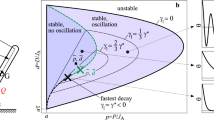Abstract
The balance control in the sagittal plane during standing without visual feedback has been studied in the context of the notion that a human body can be presented as a two-segment inverted pendulum. The oscillations of the center of pressure and of the upper and lower segments were recorded for 2 min (ten records for each of seven volunteers). It is shown that the correlation coefficients and dynamic similarity between the oscillation of the upper segment and the center of pressure are significantly higher than between the lower segment and the center of pressure. The dynamic similarity between the oscillations of the upper segment in different records are higher than between the oscillations of the lower one, which is supposedly connected with the necessity of stabilizing the head in space during standing. The oscillations of the lower segment occurred with a mean delay of 16.2 ± 9.0 ms relative to those of the upper segment. At the same time, the distribution of the delays has a peak at zero, indicating that two strategies of balance control are used during quiet standing, which are described in the one-segment and the two-segment inverted pendulum models.
Similar content being viewed by others
References
A. A. Frolov, A. V. Alexandrov, and J. Massion, in Modeling of Human Movement Control, Ed. by M. P. Shestakov and A. N. Averkin (SportAkademPress, Moscow, 2003), pp. 115–157.
Y. Aramaki, D. Nozaki, K. Masani, et al., Exp. Brain Res. 136, 463 (2001).
F. B. Horac and J. M. Macpherson, in Handbook of Physiology, Ed. by L. B. Rowell and J. T. Shepherd (Oxford, N.Y., 1996), pp. 255–292.
C. F. Runge, C. L. Shupert, F. B. Horak, and F. E. Zajac, Gait Posture 10, 161 (1999).
E. V. Bobrova, V. I. Kucher, Yu. S. Levik, and I. N. Bogacheva, Biofizika 52(2), 355 (2007).
E. V. Bobrova, Yu. S. Levik, V. Yu. Shlykov, and O. V. Kazennikov, Byull. Eksp. Biol. Med. 138(8), 152 (2004).
E. V. Bobrova, Y. S. Levick, and V. Y. Shlykov, Gait Posture 21(1), S34 (2005).
D. A. Perennou, B. Amblard, M. Laassel, and J. Pulissier, Neuroreport 8(14), 3137 (1997).
A. Berthoz, in Brain and Space, Ed. by J. Paillard (Oxford University Press, Oxford, 1991), pp. 163–184.
T. Mergner and T. Rosemeier, Brain Res. Rev. 28, 118 (1998).
N. A. Bernshtein, Essays on Physiology of Movement and Activity (Meditsina, Moscow, 1966).
A. V. Alexandrov, A. A. Frolov, and J. Massion, Biol. Cybern. 84, 425 (2001).
A. V. Alexandrov, A. A. Frolov, and J. Massion, Biol. Cybern. 84, 435 (2001).
A. V. Alexandrov, A. A. Frolov, F. B. Horak, et al., Biol. Cybern. 93, 309 (2005).
E. V. Bobrova, Zh. Vyssh. Nerv. Deyat. 57(6), 663 (2007).
E. V. Bobrova, Yu. S. Levik, V. I. Kucher, and I. N. Bogacheva, Vestn. Tverskogo Gos. Un-ta 22(50), 10 (2007).
G. Rode, C. Tiliket, and D. Boisson, Scand. J. Rehabil. Med. 29, 11 (1997).
G. Rode, C. Tiliket, P. Charlopain, and D. Boisson, Scand. J. Rehabil. Med. 30, 9 (1998).
S. L. Mitchell, J. J. Collins, C. J. De Luca, et al., Neurosci. Lett. 197, 133 (1995).
D. A. Winter, F. Prince, P. Stergiou, and C. Powell, Neurosci. Res. Commun. 12(I. 3), 141 (1993).
Author information
Authors and Affiliations
Corresponding author
Additional information
Original Russian Text © E.V. Bobrova, Yu.S. Levik, I.N. Bogacheva, 2009, published in Biofizika, 2009, Vol. 54, No. 5, pp. 935–940.
Rights and permissions
About this article
Cite this article
Bobrova, E.V., Levik, Y.S. & Bogacheva, I.N. Oscillations of upper and lower body segments in the sagittal plane during standing: Spatiotemporal relationships. BIOPHYSICS 54, 648–651 (2009). https://doi.org/10.1134/S0006350909050169
Received:
Published:
Issue Date:
DOI: https://doi.org/10.1134/S0006350909050169




